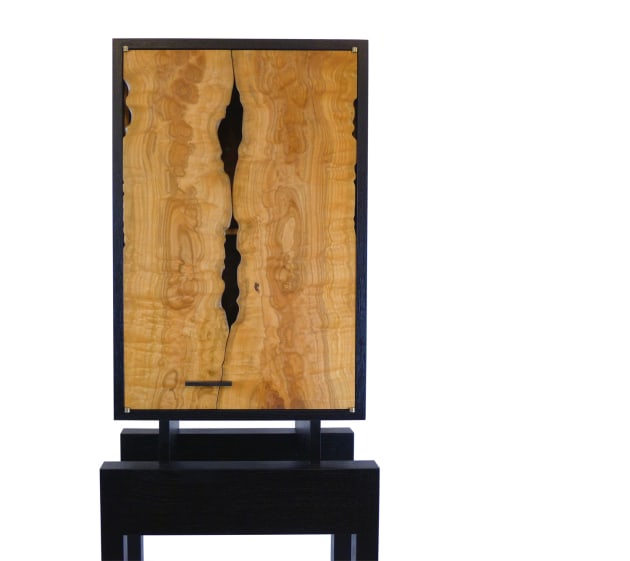Julien Hardy: learning and living the craft
Maker of the Year, presented by Carbatec is open to entrants all over the world. Entries are published on the Wood Review website as soon as they are received, and up until the September 4 closing date we'll also get to know a little more about some of our entrants. Julien Hardy lives in Montauban, France and calls himself a hybrid woodworker. We asked him to tell us about his woodworking life...
Please tell us a little about your background and how came to be a custom furniture maker.
I’ve only been a woodworker for the past 15 years. Before that, I was an art director in advertising living in Montreal. The story sounds like too much, but it is what happened. One day, I was looking for a Spanish evening class, and in the brochure, the line atop said ‘ébénisterie’. And I thought to myself I was barely able to hang a shelf, so I decided to go for it. It was an accident. I went to the class and wondered at the fact that an idea took life in realtime, became a real thing. The virus was caught. But I soon realized all these machines couldn’t fit in my apartment, So I started learning hand tools woodworking from books as classes were not available at the time. I remained almost machineless until 2020, when I got my first jointer-planer.
…and also please tell us a little about where you live and what your workshop is like please…
I live and work in a small village in the hills of the south of France. So, there isn’t much to take the focus off my work. My workshop is a mix of two eras. Machines share space with tools from the 1870s. As I’m a hybrid woodworker, I rely a lot on hand tools for joints and finessing. Machines content themselves with the grunt work. So it’s a curious half-and-half between industrial and bucolic.
How did you learn the craft?
As I said, mainly books, and trial and error, with an accent on error for a long while. I’ve always kept to trying something new on every project. To keep learning and to keep the interest alive. And get cold sweats.
Julien Hardy, nature against Nature (detail), solid oak and cherry ‘from my village’, shortlisted in Top 100, Maker of the Year 2023.
What’s important to you as a maker?
The technique is a thing. But it’s only a tool. The best aspects for me are the ideation, and the final reveal. But the process in between both has its perks. I particularly enjoy the «meditation» of using hand tools, taking the time to do things right rather than fast, crunching my wheels on a complex joint, arranging the wood’s grain and colours the best way possible, and always keeping the doors opened for as long as possible to adjust or change an aspect of the piece as I go along. That’s why I rarely draw precise plans. And finally, it’s how people react to my pieces, I admit.
Julien Hardy, Sideboard at will, maple and white oak ‘with a considerable hint of minimalism’.
You describe your work as contemporary but traditionally made and it seems traditionally inspired. How would you describe your style?
I’m not sure I have a style. I mean, yes I have this thing with apparent and/or through joints that, to me, bring depth, quality and meaning to a piece, and I also have a thing for simple streamlined lines, almost austere. But in terms of style, I have the feeling that I prefer to explore various influences to learn more rather than build a catalogue or collection. That’s why I only do one-offs, and sometimes pair two pieces stylistically. It might not be the best commercial idea, but it is my way to keep the passion alive and well.
I also think style is very much influenced by the essences available where you live (not a big fan of import/export). When you get highly figured or coloured woods you’re not going to build the same pieces as when you get straight, very regular woods. In that sense, we’re very much influenced by our environment.
But if we need to name names, I was very much influenced by The Krenov, the Shakers, Mid-Century Modern, the American side of the Arts & Crafts movement and the American Studio Craft.
Can you tell us more about the piece you have entered in this year’s Maker of the Year presented by Carbatec Awards please? Was it a custom order and if so, how tight was the brief (did your clients give you free rein for example)?
This particular piece, Black Forest (detail shown above), is an extension of a series of decorative veneered panels I made some years ago that I called ‘woodings’ in reference to paintings. One of them was a case with the same idea of veneered panels in grooves recreating a forest although that first one was in live-edged veneer. I’ve wanted for a long time to include this idea into a furniture piece, and somehow, make it interactive so that furniture could become more than stylish storage (please note I have nothing against stylish storage). But I guess the core idea, in this piece and others, is to try to rebuild the link between wood the material, and wood the living thing, the forest, the painting from Nature. Bring life back to the material.
What are you working on now?
Building a showroom for my non-commissioned work. And wondering what the next piece will look like.
What is the best thing about woodworking and the lifestyle you have chosen?
Doing what I love. Creativity. Freedom. It has a price, but I’m glad to pay it.
See Julien’s entry for 2024 Maker of the Year presented by Carbatec here
Enter Maker of the Year, presented by Carbatec
MAJOR SPONSOR
SUPPORTING SPONSORS










